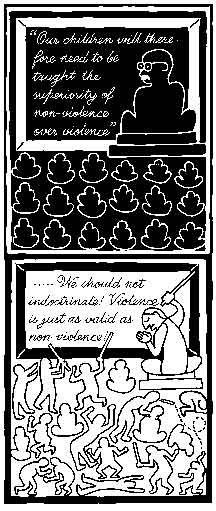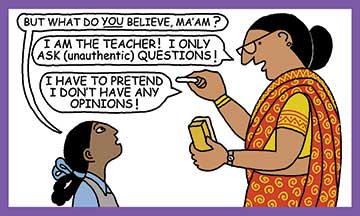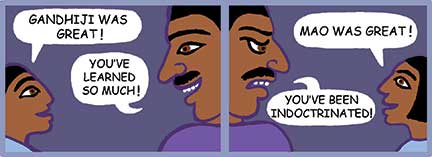Rohit Dhankar
The ideal of citizenship is conspicuous by its absence in the current government-led policy debate.
It would be useful to look at one important milestone in Indian educational thought to underline the role such ideals play. The milestone I intend to look at is The Wardha Scheme of education. I am taking the Basic National Education: Report of the Zakir Hussain Committee1 as the main text for the Wardha scheme on the authority of Dr. K.L. Shrimali. He uses the report as being synonymous with the Wardha scheme and states that it was “approved by Gandhiji”2.
 The report was the outcome of a churning of ideas first in the form of debates through the newspaper published by him in which Mahatma Gandhi was a central figure and then the Wardha National Education Conference on 22nd and 23rd October 1937. The conference appointed a committee under the chairmanship of Dr. Zakir Hussain. The committee included stalwarts like K T Shah, VinobaBhave, Kaka Kalelkar, and E W Aryanayakam. This is a very thoughtful and well written report. In spite of not being very long it touches almost every aspect of school education including general theoretical moorings, curriculum, syllabus, examination, and teacher education. In this article the focus is only on the ideal of citizenship in this scheme of education.
The report was the outcome of a churning of ideas first in the form of debates through the newspaper published by him in which Mahatma Gandhi was a central figure and then the Wardha National Education Conference on 22nd and 23rd October 1937. The conference appointed a committee under the chairmanship of Dr. Zakir Hussain. The committee included stalwarts like K T Shah, VinobaBhave, Kaka Kalelkar, and E W Aryanayakam. This is a very thoughtful and well written report. In spite of not being very long it touches almost every aspect of school education including general theoretical moorings, curriculum, syllabus, examination, and teacher education. In this article the focus is only on the ideal of citizenship in this scheme of education.
Wardha scheme is obviously part of the Gandhian thought on education; but this also has contributions from the conference, from the committee members, and it is no difficult task to see that in spite of being written under Gandhi’s guidance, many of Gandhi’s ideas are also modified, if not compromised, in this. For example, the report does not demand that schools be financially self-supporting through their own production in the process of learning; it only recommends that and expresses a hope of realizing this goal with the government’s help. But it mentions Gandhi several times, included two letters to Gandhi by the committee and states that it is an authentic expression of Gandhi’s ideas on education. Gandhi himself, as indicated above, approves it. In his foreward to the report, however, Gandhi does not seem to be totally satisfied by the title of the report. He thinks that a “more correct though much less attractive description” of the report “would be Rural National Education through village handicrafts.” His explanation baffles an ordinary reader . He says that ‘rural’ will exclude “the so called higher or English education”. One would think rural excludes urban also, and that is the more important meaning of the term. But does that mean that Gandhi thought this education was fit only for the village children? He does say in the preface that the report should communicate that for the framers “the scheme expect(s) the teachers to educate village children in their villages” through “village handicrafts”.
Basic schools, however, were opened in rural as well as in urban areas and perhaps more urban middle class children were educated through this than the rural children. Also, the term ‘national’ in the title of the report can be seen as encompassing the whole nation, irrespective of rural or urban. But then Gandhi’s explanation of the term ‘national’ baffles one even more. He says: “‘National’ at present connotes truth and non-violence.” It is possible to claim, unjustifiably though, that truth and non-violence were at that time ‘nationally accepted’ ideology; but how can ‘national’ connote that? Is it not tantamount to saying that any ideas that do not accept the ideology of truth and non-violence cannot be considered national? What does this claim do to the more common definition of national used by ordinary mortals: “concerned with or applicable to or belonging to an entire nation or country”?
After these preliminary remarks we should turn to the ideal of citizenship in this scheme; we will see that the above mentioned Gandhi’s characterization of ‘national’ plays an important role in the formulation of this ideal.
The ideal of citizenship
The scheme has a very strong and clear ideal of citizenship that runs through the report and informs all of its formulations. This ideal is also explicitly stated in a small section which is so pregnant with ideas that one can easily write a book making those 328 words the sole basis for it. Therefore, what I say below is nothing more than a glimpse of this ideal.
Cooperative community
The citizen in this scheme is situated in a “cooperative community” which is civilized, has social and political equality and is caring for every member. Not directly mentioned here but if one looks at Gandhi’s ideas regarding social organization, it is an autonomous and largely self-reliant community which takes care of its governance and economic needs with a large degree of independence. And is fairly close to his ideal village republic.
The political ideal
The report prophecies that the “citizenship” in modern India “is destined to become increasingly democratic in the social, political, economic, and cultural life”. Which directly requires from every citizen an “understanding” of his/her “own problems and rights and obligations.” According to the report a “completely new system is necessary to secure the minimum of education for the intelligent exercise of the rights and duties of citizens.” (Emphasis added) The idea that citizens have rights immediately demands the capability to exercise those rights in a thoughtful manner. And of course, rights come attached with duties. It seems to me that the greatest failure of Indian education after Independence lies in its lack of capability to help future citizens to be able to exercise their rights and duties in an intelligent manner.
Economic ideal
The scheme declares quite clearly that “[a]n education which produces drags and parasites – whether rich or poor – stands condemned.” Every citizen in this scheme is envisaged to be both capable and willing “to repay in the form of some useful service what he owes to it as a member of an organised civilised community”. The ideal is not merely concerned with social efficiency; as production of parasites also “engenders a dangerous and immoral mentality”. In such a scheme all work and labour, including “scavenging”, naturally has to be seen as equally honourable. The moral emphasis on work takes it beyond the efficiency paradigm and is unmistakable in the report.
Transformative and moral expectations from education
The children who are educated in such a scheme, directly contributing to useful productive work in an environment of cooperation and democratic decision-making are supposed to develop a commitment to these ideas and are also supposed to take them forward in the community beyond the school. Thus education is for the moral and intellectual transformation of the society at large.
 Personal qualities
Personal qualities
Achievement of or failure to realize these ideals obviously depends on the transformation and development of capabilities of the children who are being educated through the scheme. Therefore they are supposed to develop into “the citizens of the future” with “a keen sense of personal worth, dignity and efficiency” and education should “strengthen in them the desire for self-improvement and social service in a co-operative community.”
This five-fold ideal of the society and citizenship is powerful, clear and can become a basis for aims and ideals of education in any democratic society, of course, appropriately interpreted in the context.
And still, the Wardha scheme has at the least one very serious philosophical problem if examined in terms of education in a democracy. It’s pedagogical and curriculum related problems are well known as no single handicraft can bear the burden of achieving all learning objectives through productive work. To my mind this is no great philosophical problem. As today, we may not know how to formulate a curriculum that can achieve all academic learning through productive work through a central handicraft; but there is nothing conceptually impossible about it; as in future through empirical research we may be able to solve this fundamental problem. What I am indicating in this article is a contradiction of different nature, and to my mind much more serious.
Is the scheme dogmatic?
Let me ask the question without mincing words: is the Wardha scheme dogmatic in a seriously problematic sense?
To understand this let’s look at some ideas in the scheme. We can start with recollecting Gandhi’s characterization of ‘national’ where he says that national “at present connotes truth and non-violence”. The report itself gives this definition of ‘national’. It claims that education for Indian children has to be “radically” different from education in the West, as unlike the West “in India the nation has adopted non-violence as the method of peace for achieving all-round freedom. Our children will therefore need to be taught the superiority of non-violence over violence.”
This, in spite of Congress being the main party fighting for free India and Gandhi being the unquestioned (and that is the problem, by the way) leader of that party, was not true of India in 1937-38, never has been, and never can be. This is exclusionary in the sense that there were still nationalist extremists who did not mind armed struggle to win freedom, there was Subhas Chandra Bose who did not agree on this ideal, there was Nehru who accepted non-violence only as a strategy, there was the Left movement which never accepted it, and there was the Muslim League who considered it as indoctrination of children into Hindu values. One could hardly declare this ideal ‘national’ without excluding all these streams of thought which were right within India and as concerned about its betterment as Gandhi was.
 It requires much more space than available for this article to do justice to this issue. Therefore, I will limit myself to paraphrasing the All-India Muslim League’s criticism of inclusion of the doctrine of ahimsa in a scheme of education. The council of AIML appointed a committee to examine the impact of the implementation of the Wardha Scheme on Muslims of India under the chairmanship of the Raja of Pirpur. The report of the committee, of course, has much that is unfounded and expresses only AIML biases; but the criticism of the scheme for inclusion of non-violence is sound and well argued.
It requires much more space than available for this article to do justice to this issue. Therefore, I will limit myself to paraphrasing the All-India Muslim League’s criticism of inclusion of the doctrine of ahimsa in a scheme of education. The council of AIML appointed a committee to examine the impact of the implementation of the Wardha Scheme on Muslims of India under the chairmanship of the Raja of Pirpur. The report of the committee, of course, has much that is unfounded and expresses only AIML biases; but the criticism of the scheme for inclusion of non-violence is sound and well argued.
The report states that “in an educational scheme there must be scope for teaching different forms of political doctrines. If, from their childhood, boys and girls are made to think in terms of superiority of non-violence it may produce the same results as the doctrine of superiority of race has done in certain totalitarian states.” It is totalitarian in nature to “base an education scheme on the creed of a leader of a political party”. This gives education a “religious garb”. “It will … … facilitate the conversion of the youth to the ideals of the Congress.” In a country like India a “system of education which emphasises the superiority of one political ideal over others will encourage intolerance.”
AIML was looking from its own angle, but this criticism stands even in the light of democratic ideal of critical citizens with independence of mind as well; because making non-violence a central principle of a system of education is clearly indoctrination. It moulds children in a tender age to think in a particular way, which may make them incapable of rationally examining it in their future life. Which means that education will be trying to control their ways of thinking.
Implications for the curriculum
This bias is clearly visible in the curricular objectives and detailed syllabus in the report, generally in the mother tongue, social studies, and particularly in history; as is expected. We will look only at history in this article. Actually, the objectives of social studies curriculum are very laudable and can hardly be faulted. Present day curriculum framers can learn a lesson or two from the report in structure and principles of objectives based curricula. But the content selection and treatment, at many places wants uncritical acceptances of the doctrine of ahimsa. Some examples are given below.
“Stories of the great liberators of mankind and their victories of peace should find a prominent place in the curriculum. Emphasis should be laid on lessons drawn from life showing the superiority of truth and non-violence, in all its phases and its concomitant virtues, over violence and deceit.” (Emphasis added) No one in one’s sane moments can object to pointing out struggles of liberators and role of non-violence in them, if any. But making a decision before hand to show “superiority” of truth and non-violence over violence is clearly dogmatic. The issue in history should be to develop as rational and evidence based an understanding as possible. If it happens to show the superiority of non-violence, well and good; but being determined to show this superiority will itself be neither true nor non-violent. There are several examples of this nature in the scheme.
Conclusion
The Wardha Scheme of education is a landmark scheme in the development of educational thought in India. It has much more than just historical value for students of education and teacher education today. It is an exercise in brevity, clarity of expression, and structure of curriculum; particularly objectives-based curriculum. But in at least one aspect, it is also dogmatic and illustrates what should be avoided in developing educational schemes and curricula in a democratic country. It is deeply sectarian in this sense. At present, we are engaged in debating the new education policy. The pronouncements from various sections of the society and even the government raise a deep suspicion of sectarian agenda being pushed into this exercise. There are many thinkers on education who look hopefully towards Gandhi’s ideas of education as a means to resist this sectarian push. This analysis sounds a note of caution. There might be much good in his ideas on education, and they may be used; but there is much to be avoided as well. If one legitimizes the use of history and social science to indoctrinate children into the idea of the superiority of non-violence, there remains no ground for resisting use of the same to indoctrinate children into the underlining superiority of Hindu culture and need to use violence to ‘protect’ it. History and indoctrination are double-edged weapons.
References
- Basic National Education: Report of the Zakir Hussain Committee, Hindustan TalimSangh, Wardha, 1938.
- K L Shrimali, The Wardha Scheme, Vidya Bhavan Society, Udaipur, 1949. (page 80)
- Basic National Education, (Foreward.)
- I must confess here I am no Gandhi scholar, and many things Gandhi says baffle me. Nor do I find Gandhian scholars on most of such issues very satisfactory.
The author is Director, School of Education, Azim Premji University and Academic Advisor, Digantar, Jaipur. He can be reached at rohit.dhankar@apu.edu.in.
